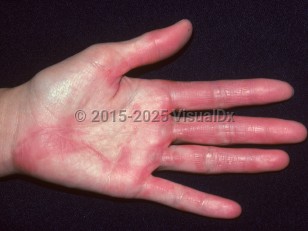Staphylococcal TSS is caused by S aureus strains that can produce the toxic shock syndrome toxin-1 (TSST-1). TSST-1 is believed to cause disease via direct effects on end organs, impairing clearance of gut-flora-derived endotoxins, with TSST-1 acting as a superantigen leading to massive nonspecific activation of T cells, cytokine release, and subsequent inflammation and vascular leakage. Staphylococcal TSS was identified in and most commonly affected menstruating young White females using tampons in the 1980s, but cases of menstrual TSS have declined with increased public education on tampon usage and TSS as well as the discontinuation of high-absorbency tampons. Current staphylococcal TSS cases are seen in postsurgical interventions, burn patients, patients with dialysis lines, and those with nasal packing. TSS following nasal surgery with packing is estimated to occur in approximately 16.5/100 000 of nasal surgeries performed. The prevalence in dialysis patients is unknown but thought to be rare.
A late 1980s study showed a lower rate of tampon usage among Black and Mexican women compared to White women, and while this may help explain the lower incidence of TSS in Black women, the authors did not believe the findings were sufficient to explain the discrepancy entirely. They hypothesized that perhaps the erythema of TSS is more difficult to see on darker skin colors, thus resulting in clinicians not reporting TSS because they failed to recognize the criteria for diagnosis.
Clinically, there is high fever that may be accompanied by hypotension. The dermatologic manifestations of staphylococcal TSS include the following:
- Diffuse erythematous patches that begin on the trunk and spread toward the extremities
- Erythema and swelling of the palms and soles with or without generalized nonpitting edema
- Desquamation, primarily of the palms and soles, that begins 1-3 weeks after the initial onset of the rash
- Erythema of the mucous membranes (strawberry tongue and conjunctival hyperemia)
Interestingly, an emerging pathogen, Streptococcus suis, which can be transmitted from pigs to humans, has been responsible for several large outbreaks of disease, including toxic shock syndrome, in Asia, specifically Thailand and China. The consumption of raw or undercooked pork is the number one risk factor. In one Thai study, 23% of patients with positive cultures developed TSS, and the mortality rate from infection with certain serotypes of S suis has proven to be exceptionally high. Thus, this new pathogen has been a cause of great concern worldwide.
All forms of TSS can result in end organ damage presenting as confusion and coma, renal impairment, liver impairment, adult respiratory distress syndrome, and disseminated intravascular coagulation. Supportive measures (eg, intravenous fluids, vasopressors) and appropriate antibiotics are the mainstays of treatment.
Immunocompromised patient considerations: Although infections with S aureus are common in HIV-infected individuals, the complication of TSS is rare. This is thought to be related to the immune deficits and T-helper cell dysfunction seen in HIV disease. However, in cases that have been reported, they tend to present with a recurrent and prolonged disease course. Attributed to delayed antibody production against TSST-1 by HIV-infected individuals, a protracted disease course has been reported in HIV-infected adolescents, adults, and children.
Note: In December 2022, the Centers for Disease Control and Prevention (CDC) issued a Health Alert Network (HAN) Health Advisory to notify clinicians and public health authorities of an increase in pediatric invasive group A streptococcal (iGAS) infections in several states. During 2023, there has also been an increase in iGAS infections among persons aged 65 and older. Other groups at higher risk for iGAS infections include American Indian and Alaska Native populations; residents of long-term care facilities; people with underlying medical conditions, including diabetes, malignancy, immunosuppression, chronic kidney disease, cardiac disease, or respiratory disease, wounds, and skin disease; people who inject drugs; and people who are experiencing homelessness. Severe outcomes of iGAS infections include necrotizing fasciitis, streptococcal toxic shock syndrome, and death.



